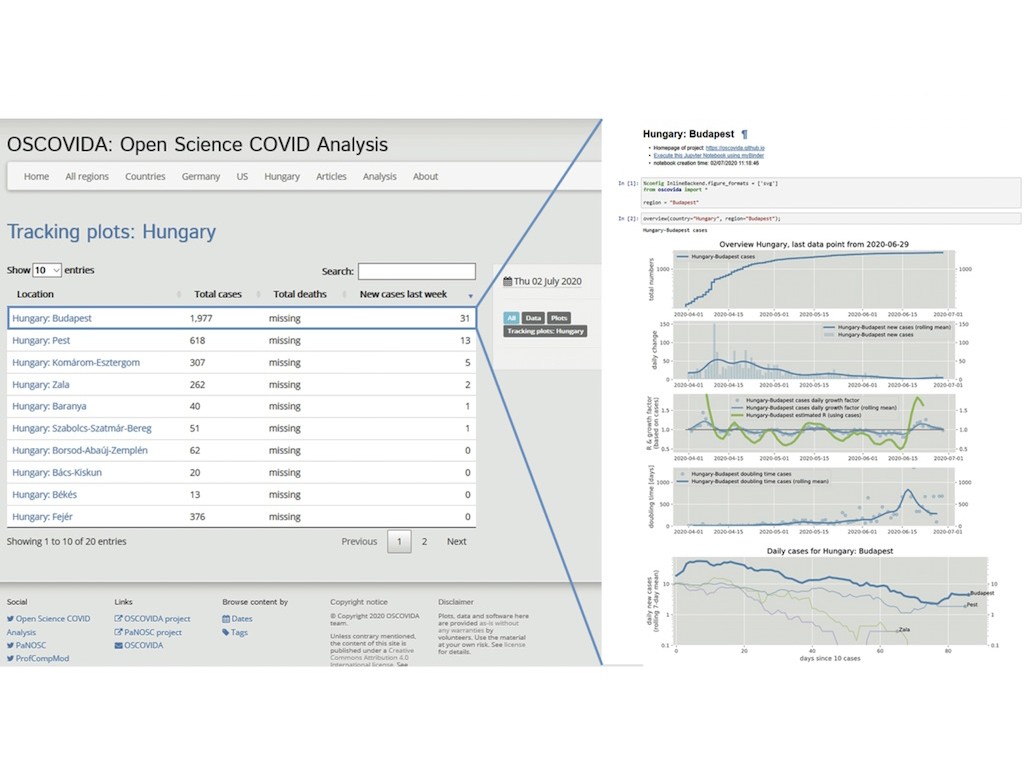Hungarian contribution to PaNOSC OSCOVIDA allows following COVID-19 pandemic in the country at county level
The COVID-19 pandemic is an enormous challenge for all countries. European XFEL contributes on multiple frontiers including the PaNOSC (www.panosc.eu) supported citizen science platform OSCOVIDA (https://oscovida.github.io/) for analysing the outbreak. "One of the biggest challenges is to get the data and organise it in a way that others can properly interpret and reuse it efficiently" - explains Prof. Dr. Sandor Brockhauser, leader of the Open Scientific Computing Group at European XFEL and member of the Research Data Alliance (RDA) COVID-19 Working Group. Brockhauser adds - "The OSCOVIDA project initiated by Prof. Hans Fangohr, provides the public with an easy to use python based Jupyther notebook, where data on the evolution of the pandemic in all countries worldwide can be analysed. Unfortunately, we could integrate data on regional or sub-regional scale only in relation to Germany, thanks to the contribution of the Robert Koch Institute. As Research Professor at the University of Szeged, I opened a project on github to enable integrating data (originating from koronamonitor.hu) on county level from Hungary, too. Converting data from a google spreadsheet and providing them in a python environment under github brings them close to citizens." In Hungary, as in most of the countries worldwide, the government has tried to take protective measures based on accurate data. Due to this, many projects have started to collect a diverse set of information, such as people's transportation habits, their number of contacts, and more. This data has been valuable to take appropriate actions so far, while the number of new cases and deaths have been continuously monitored to observe the effects of such actions. Even though protective measures in Hungary worked out relatively well, we found out that COVID-19-based data is hard to find publicly, at least in a downloadable and processable form. Therefore, the Software Engineering Department at the University of Szeged led by Prof. Dr. Rudolf Ferenc decided to join the PaNOSC open-science initiative and contribute to the OSCOVIDA project, to help the integration of the COVID-19 data for Hungary. We continuously monitor, download and transform available data sources to provide easily accessible data that can be processed with Python scripts with a few lines of code and is open to everyone. This external contribution to the PaNOSC initiative is led by Prof. Dr. Sandor Brockhauser, head of Open Scientific Computing at European XFEL and leader of the X-ray Crystallography Laboratory at the Biological Research Centre. Main contributors from the University of Szeged are Prof. Peter Hegedus and Otto Kiss. Acknowledgements: - European XFEL, Germany - https://www.xfel.eu/ - Biological Research Centre, Szeged - http://www.brc.hu/ - Dept. of Software Engineering, University of Szeged, Hungary - https://www.inf.u-szeged.hu/en/sed - Atlo Team for gathering and providing data from Hungary - https://atlo.team/koronamonitor/ - Github for hosting repository and data files - https://github.com/ Read more on OSCOVIDA here: https://www.panosc.eu/news/panosc-open-science-covid-analysis-platform/ Watch the video interview with Prof. Hans Fangohr on data analysis services and OSCOVIDA - Open Science COVID-19 Analysis website: https://www.youtube.com/watch?v=1_oDc_vptBQ
Keywords
EOSC, PaNOSC, OSCOVIDA, COVID-19, open data, citizen science, open scientific computing



